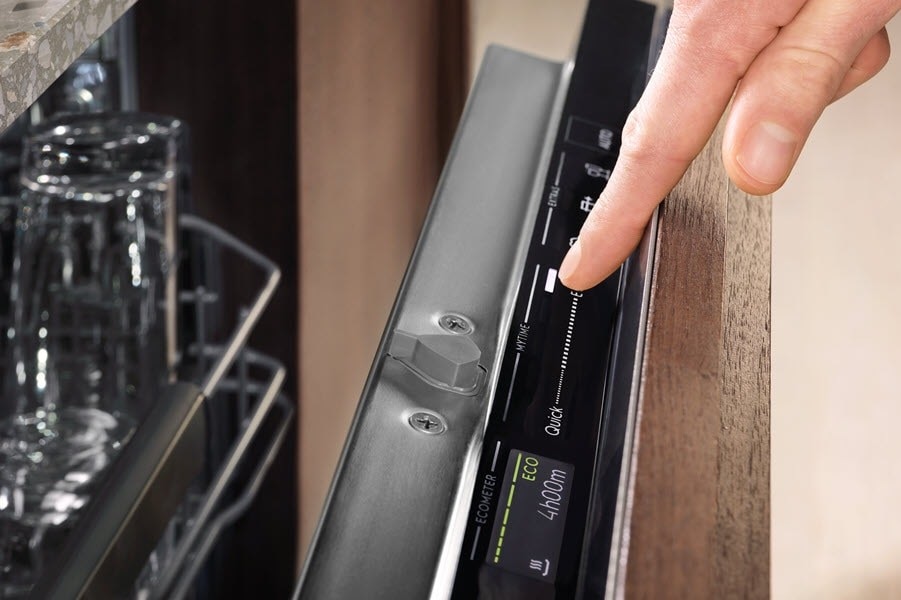Welcome to OneClickSupport Know more
If you’re using your dishwasher for the first time (or it has run out of salt), you will need to add dishwasher salt.
The purpose of dishwasher salt is to soften the water, since hard water with high lime content makes it harder for the detergent to dissolve when the machine is running. That means the salt makes your cleaning more efficient.
The salt is added at the bottom of the dishwasher. Remove the bottom rack and open the screw cap that covers the salt compartment. If you’re unsure of where to add salt in your dishwasher, check your user manual.
How much dishwasher salt to add is also a common concern. The correct way is to add salt until the compartment is completely full, then replace the screw cap and the bottom rack.
Rinse aid helps avoid unsightly water stains or other residue on your dishes. It is usually added next to the detergent compartment. Open the rinse aid compartment’s lid and add rinse aid up to the fill line. Then close the lid.
Rinse aid has to be refilled much more often than salt, so make sure to keep an eye on your dishwasher’s rinse aid indicator. It will let you know when it needs a refill.
The bottom rack of your dishwasher is usually the place where the strongest cleaning happens. The water jets here are designed to tackle heavily soiled pots and pans as well as plates, so make sure not to place lightly soiled plastic cups or Tupperware bowls here. They may deform.
Instead, use this large compartment to place your pots and pans, your plates and large bowls. Remember to place dishes in the dishwasher with the soiled surfaces facing down to ensure perfect cleaning.
As for plates, place them vertically in the rack. You don’t need to leave more free room between them than the rack allows, by the way. Don’t waste space by only putting plates in every other rack opening.
If your dishwasher has a basket for cutlery in the bottom rack, place your cutlery in it, with the handles facing down. However, you may want to place sharp knives in the basket with the blades facing down to avoid injury.
Alternatively, place knives and other long utensils between your cups and bowls in the top rack, with the blades facing down. Best option is to choose a dishwasher with dedicated cutlery rack at the top of the appliance. place cutlery in it with any sharp blades facing down.
In the top rack, place glasses and cups with their bottoms up to allow the water jets to spray the inside of glasses without water getting collected in them. There is also usually room in the center to place small bowls or saucers that are too small for the bottom rack.
A question that often comes up in this context is: can you put ceramic mugs in the dishwasher? The answer is yes. Because they’re glazed, they’re usually dishwasher-safe. However, be cautious with mugs that are hand-painted. The dishwasher may wash off the paint, so it may be a better idea to clean hand-painted mugs by hand.
Before you close your dishwasher after loading it, make sure that the water sprayer arms aren’t obstructed by any dishes.
Dishwasher detergent comes in many different forms, from liquid and gel to powder to tablets and packs. Which form of detergent you want to use is up to you, just ensure that you know how to use the correct amount.
Using the correct amount is generally easier with tablets and packs. You just use one of them.
With other detergents, follow the instructions on the package as well as in your dishwasher’s manual. Using powder dishwasher detergent, liquid or gel dishwasher detergent, you usually fill up the detergent compartment to the fill line.
Always make sure to use detergent that is designed for use in dishwashers. Never use normal dishwashing soap in your dishwasher.
Check out our tips on how to choose a dishwasher.

A big part of knowing how to use dishwasher machine correctly is choosing the best program for your dishes.
Depending on the manufacturer, dishwashers may offer different programs, but almost all share three basic cycles:
Electrolux dishwashers also offer an Eco program that helps you save more water and energy with extra-efficient cleaning. Some Electrolux dishwashers also have an Extra Hygiene function that kills off 99.99% of bacteria and viruses.
All author postsWe sincerely appreciate your prompt response in resolving this unexpected issue.

Consistency is one of your biggest strengths. I can always count on you to treat all of your tasks with importance while also recognizing the value of prioritizing. Keep up the good work

I am truly impressed with how you have managed to meet every goal set before you
